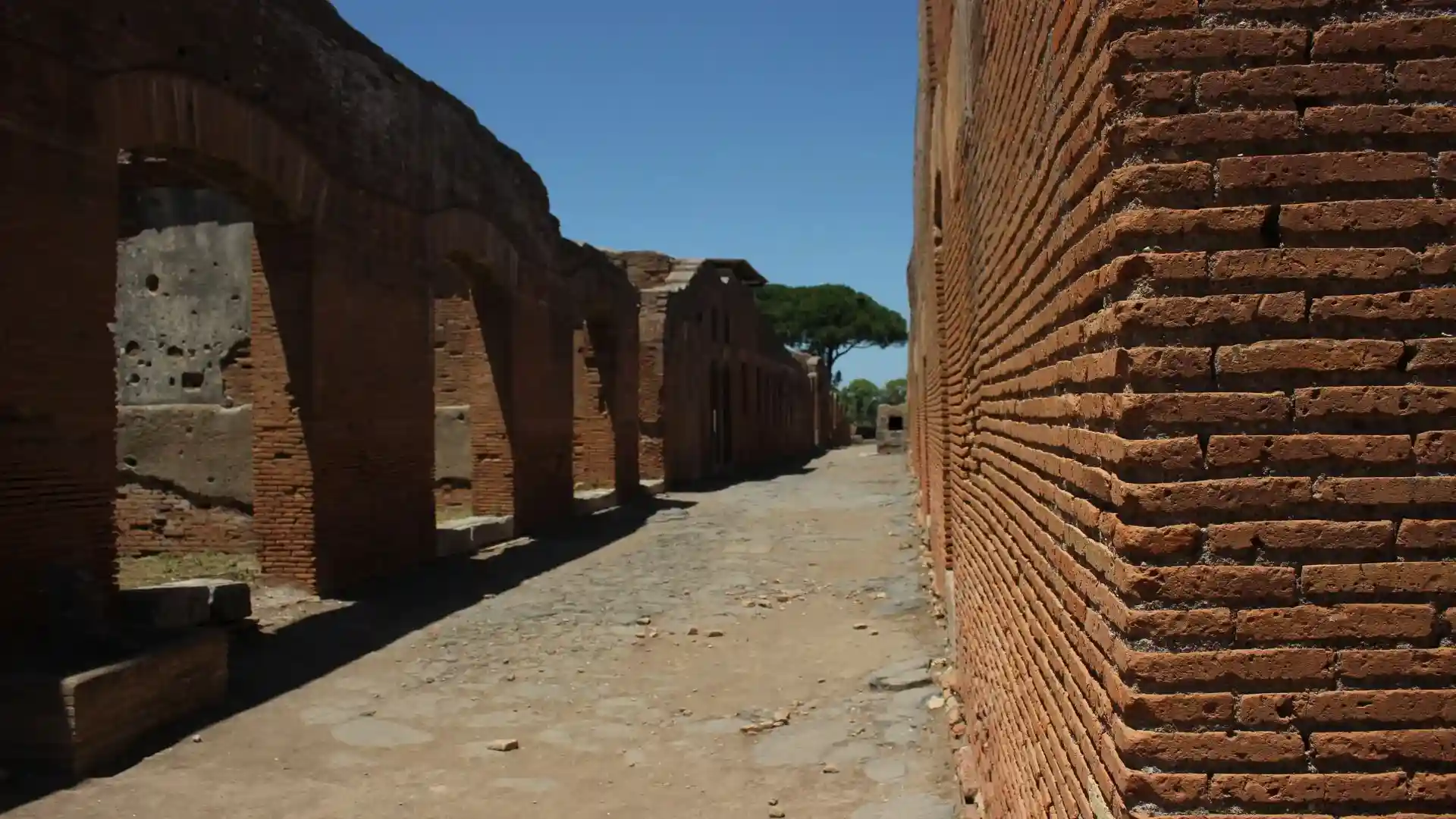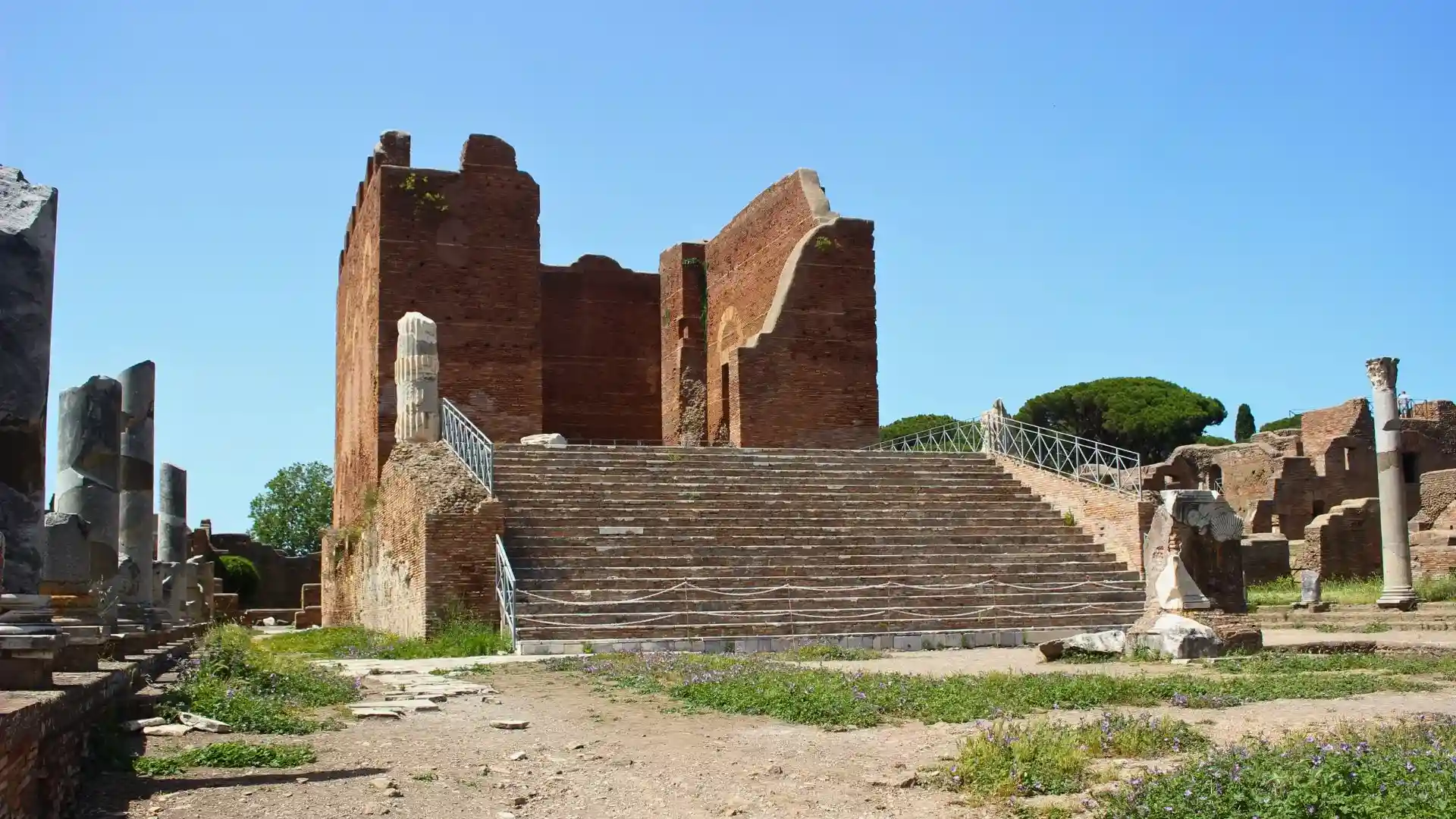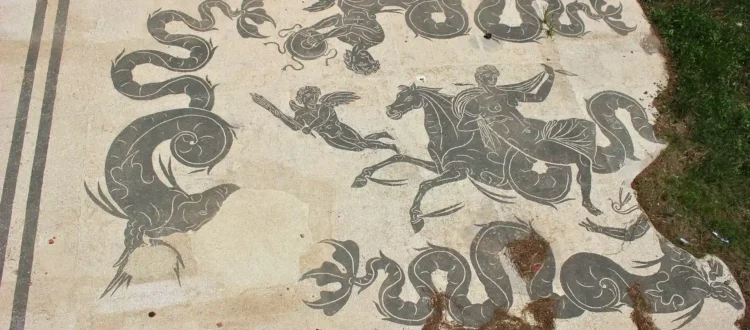Ostia Antica. A walk through the ruins of the ancient city
Are you in Fiumicino and unsure how to spend the hours before your next flight?
Not far from our seaside town lies a true treasure: the ruins of Ostia Antica, the Roman city that once guarded the ancient mouth of the Tiber River. Initially built as a fortified camp (castrum), it later became a lively urban center, a crossroads of cultures and commerce.
Cross the gate and let yourself be guided on a journey back in time, through cobblestone streets, shops, and majestic temples, whose remains tell the story of everyday life in a bustling port city.
A walk along the Decumanus Maximus, between shops, warehouses, and private homes
We enter the city through Porta Romana, one of Ostia’s main access points.
In the Republican era, the city was surrounded by protective walls. This majestic entrance once saw the constant passage of soldiers, merchants, and travelers from every corner of the Roman Empire, carrying goods and stories. Today, only a few remnants of this monumental structure remain, but they are enough to evoke its former grandeur, allowing us to imagine it in all its splendor, entirely covered in marble, with refined decorations and dominated by two imposing statues of the goddess Minerva, symbol of wisdom and protection.
Passing through this threshold, we walk along the Decumanus Maximus, the backbone of the city, the road that, following the path of the Via Ostiense, crossed Ostia from east to west. Here, the activity was immense.

Along the road, shops of all kinds opened, offering passersby the most varied goods: from freshly baked bread to wine from the surrounding countryside, from exotic spices coming from the East to precious fabrics arriving from the farthest provinces.
These retail shops (tabernae) were mainly run by freedmen, former slaves who, once freed, chose to dedicate themselves to trade. It was a job that allowed them to accumulate wealth and establish themselves as important members of the community.
As a port and commercial city, Ostia was a crucial hub for storing goods that arrived by sea and were then distributed to Rome and other cities of the empire. Along our path, we frequently encounter large warehouses (horrea) designed to store essential goods for the supply of the capital. Grain, oil, wine, and other food products were stored in these large buildings, specifically constructed to keep goods for long periods.
The horrea had thick walls to protect the goods from damage caused by heat, humidity, and fires, which were unfortunately quite frequent in such a populous city rich in easily inflammable materials.
Often, the shops were located in larger buildings – called insulae – which were very similar, in some ways, to modern apartment complexes.
The upper floors were occupied by private homes. These multi-story buildings represented a practical and efficient living solution, especially suitable for the urban life of a city like Ostia, where population density was high, and space was limited.
However, the insulae could become deadly traps.
The wooden structures and flammable materials used in the construction of homes and shops greatly increased the risk of fires, which could spread rapidly in a crowded building. The lack of proper evacuation systems and the difficulty in accessing escape routes made the upper floors, where families and freedmen lived, particularly dangerous.
This explains why, at one point in its history, Ostia was equipped with a cohort of vigiles urbani, sent directly from Rome by Emperor Claudius. These soldiers were not only responsible for public safety but also had the crucial task of extinguishing fires, protecting both the citizens and the precious warehouses.
The Baths and the Theater of Ostia Antica
In a lively and industrious city like Ostia, public places dedicated to wellness and leisure played a central role, offering both residents and travelers moments of relaxation and spaces to enjoy social life. The baths, ubiquitous in Roman cities, were not simply spaces for personal hygiene, where one could take a hot bath or indulge in a relaxing massage. They were true centers of gathering and culture, where, alongside warm and cold pools, one could find large gyms for physical activity, theaters for enjoying entertaining performances, restaurants, inns, and even libraries where anyone could stop to read.
Ostia had several bath complexes:
- The Thermae of Neptune, still visitable today, from whose terrace we can admire a splendid floor mosaic depicting marine animals and aquatic deities.
- The Baths of the Forum, located in the central area of Ostia, represent the largest thermal complex in the entire city. Their strategic location made them a very popular place, both for those seeking relaxation after a day’s work and for those wanting to meet friends or conduct business.
- The Thermae of Porta Marina.
- The Thermae of the Seven Sages, named by archaeologists due to the discovery of a series of frescoes depicting the legendary philosophers of antiquity, which highlight the connection between culture and physical well-being.
- The Thermae of the Cisarii, probably owned by the eponymous guild of cartwrights.
- The Thermae of Matidia, dedicated to the mother-in-law of Emperor Hadrian.
Continuing on our walk, we also encounter the great Theater of Ostia Antica, built during the reign of Augustus and later expanded, capable of hosting 4,000 spectators on its stone steps.
Here, comedies, tragedies, musical performances alternated, and major events related to the political and religious life of the city were celebrated. The evocative atmosphere of those moments still comes to life today, during summer evenings, when the stage comes alive again with concerts, theatrical performances, and festivals, reviving the ancient vocation of this place.
The Capitolium and Mithraea: Religion in Ostia Antica
We could not conclude our visit without seeing the places that embodied the spiritual heart of Ostia, reflecting the deep devotion and religious traditions that permeated the daily lives of its inhabitants.
Heading toward the center, we stop in front of the Capitolium, the majestic temple dedicated to the Capitoline Triad—Jupiter, Juno, and Minerva—which symbolizes the unbreakable bond between Ostia and Rome.

Climbing the steps, we can still imagine the crowd gathered for the most important occasions inside the temple, the priests in togas officiating sacrifices, the smoke of incense rising, carrying hopes and prayers to the heavenly gods.
This place was the heart of official religion, the symbol of the Olympian gods’ grandeur and their protection over the city.
But in Ostia, devotion also took on a more intimate and mysterious face, hidden in the less conspicuous corners of the city.
Far from the monumental Capitolium, deep within buildings and subterranean chambers, the Mithraea were concealed—places dedicated to the secret cult of Mithras, an Eastern deity linked to the sun and rebirth. The Mithraeum of the Baths of the Forum, one of the most famous, still preserves the altar carved with the image of Mithras sacrificing the sacred bull, a symbolic ritual representing the struggle against darkness and the triumph of light.
To visit the Ostia Antica excavations, here are some practical details:
Opening hours:
- From October 25 to February 28/29: Last entry at 3:30 PM, closing at 4:30 PM.
- From March 1 to March 31: Last entry at 4:15 PM, closing at 5:15 PM.
- From April 1 to September 30: Last entry at 6:00 PM, closing at 7:00 PM.
- From October 1 to October 24: Last entry at 5:30 PM, closing at 6:30 PM.
- Closed on Mondays, January 1, and December 25.
The ticket office closes one hour before the closing time.
Ticket prices:
Full price: €18 – valid for 8 consecutive calendar days, granting access to all archaeological and museum sites of the Park.
Reduced price: €2 (for young people from the European Union aged 18 to 25), valid for 8 consecutive calendar days, granting access to all archaeological and museum sites of the Park.
Payments can be made in cash or via electronic payment at the ticket office.
The online ticket can be purchased at the following link: buy the ticket.
Tickets can also be purchased directly on the Italian Museums App.
For further information: Ostia Antica Archaeological Park ticket information.
You can purchase tickets on-site or online to avoid queues.
Official website of the Ostia Antica Archaeological Park
For more details, visit the official website of the Ostia Antica Archaeological Park: Ostia Antica Archaeological Park.










